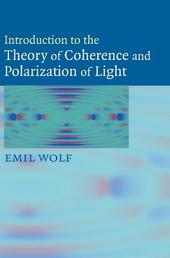
|
Introduction to the Theory of Coherence and Polarization of Light
Hardback
Main Details
| Title |
Introduction to the Theory of Coherence and Polarization of Light
|
| Authors and Contributors |
By (author) Emil Wolf
|
| Physical Properties |
| Format:Hardback | | Pages:236 | | Dimensions(mm): Height 255,Width 179 |
|
| Category/Genre | Optics |
|---|
| ISBN/Barcode |
9780521822114
|
| Classifications | Dewey:535.2 |
|---|
| Audience | | Professional & Vocational | |
|---|
| Illustrations |
25 Halftones, unspecified; 50 Line drawings, unspecified
|
|
Publishing Details |
| Publisher |
Cambridge University Press
|
| Imprint |
Cambridge University Press
|
| Publication Date |
11 October 2007 |
| Publication Country |
United Kingdom
|
Description
Before the development of lasers, all available light sources, whether used in laboratories or found in nature, generated light which underwent uncontrollable fluctuations inherent in the emission process. Such fluctuations are detrimental to many applications. This effect is almost completely suppressed in laser radiation, making it possible to use lasers for a variety of applications. The underlying theory of fluctuating optical fields is known as coherence theory. Another manifestation of the fluctuations is the so-called phenomenon of polarization. This book is the first to provide a unified treatment of these two aspects of statistical optics, made possible by very recent discoveries, largely due to the author of this book. This will be of great interest to graduate students and researchers in physics and engineering in optical communications, the propagation of laser beams through fibers and through the turbulent atmosphere, and optical image formation. Each chapter contains problems to aid self-study.
Author Biography
Emil Wolf is Wilson Professor of Optical Physics at the University of Rochester, and is renowned for his work in physical optics. He has received many awards, including the Ives Medal of the Optical Society of America, the Albert A. Michelson Medal of the Franklin Institute and the Marconi Medal of the Italian Research Council. He is the recipient of seven honorary degrees from Universities around the world. Professor Wolf co-authored the well-known text Principle of Optics (with Max Born, seventh edition, Cambridge University Press, 1999) and Optical Coherence and Quantum Optics (with Leonard Mandel, Cambridge University Press, 1995). He is also editor of the well-known series Progress in Optics.
Reviews'A succinct and informal, yet precise, account of the theory of optical phenomena involving fluctuating fields, distilling a lifetime's wisdom by a master of the subject.' Michael Berry, Bristol University 'This is a wonderfully accessible, but fully rigorous, account of classical coherence theory. The book leads us from the basic descriptors of random processes through to advanced concepts of coherence and polarization. It's a little gem that should make this tricky subject easier to understand.' Chris Dainty, National University of Ireland, Galway and Imperial College, London 'Emil Wolf's new book presents in an accessible, student-friendly manner the theory of partially coherent light, written by one of the world's leading researchers in this field. It includes treatments of the very latest results, such a coherence-induced spectra changes and partially polarized light, and fills a notable gap in the literature.' Daniel James, University of Toronto 'This is a superb introduction to a subject of central importance to modern optics, and one to which perhaps no one has contributed more than Emil Wolf. Students and researchers seeking a readable account of the coherence and polarization of light will likely find exactly what they need in this attractively thin volume.' Peter Milonni, Los Alamos National Laboratory 'Professor Wolf's latest book on coherence succinctly summarizes his many years of research experience in the field and presents a finely tuned presentation for students.' Eric van Stryland, CREOL, University of Central Florida 'A comprehensive treatment that is the first to connect the subjects of coherence and polarization, written by one of the pioneers of physical optics.' Taco D. Visser, Free University, Amsterdam ' ... a reliable and valuable source of reference.' The Imaging Science Journal
|